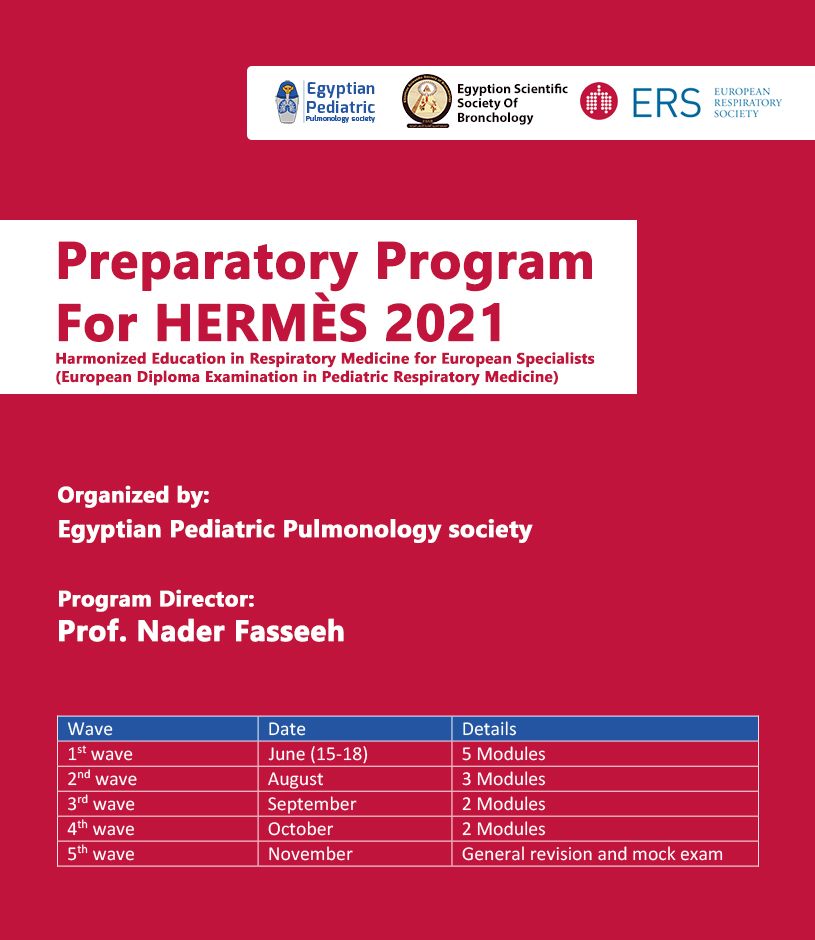
Since their creation in 2008, the HERMES examinations in adult and paediatric respiratory medicine have served as the standard of knowledge-assessment for respiratory specialists at European level and are recognised within the profession worldwide.
The multiple-choice examinations are based on European syllabi in respiratory medicine published in Breathe and the examination blueprint. Each question undergoes a rigorous process of formulation and validation by European representatives who ensure that current, as well as authentic professional situations, are illustrated.
The examinations are accredited by the European Board for Accreditation in Pneumology (EBAP) and approved by the European Union of Medical Specialists (UEMS) and the European Academy of Paediatrics (EAP).
There are 51 CME credits assigned to the European Diploma examination category and 6 CME credits assigned to the Self-assessment and In-training categories.
If you have completed your national programme or are in your final year of speciality training, you are eligible to join a highly qualified group of respiratory professionals from across Europe as a Diplomat. A Diploma is proof of excellence in the field which demonstrates commitment to life-long learning, can boost your mobility, and enables you to self-assess as a professional.
Evaluation of respiratory symptoms and signs
- Physiology of cough, shortness of breath, noisy breathing including wheeze, snoring, stridor
- Evaluation and management of isolated cough
- Evaluation and management of dyspnea
- Evaluation and management of noisy breathing
- Understanding of validity of symptoms and signs
Pulmonary function testing
- Anatomical and developmental respiratory physiology in health and disease including ventilation-perfusion and gas exchange
- Measurement and interpretation of flow-volume curves
- Measurement and interpretation of lung volumes
- Definitions of measured indices
- Test variability and reproducibility
- Performance of and interpretation of reversibility testing
- Performance and interpretation of bronchial provocation testing
- Performance and interpretation of exercise testing for the diagnosis of exercise –induced bronchoconstriction
- Blood gas assessment and oximetry interpretation
Airway endoscopy
- Anatomy, physiology and pathology of the respiratory tract of pediatric patients
- Performance of flexible endoscopy of the airway in pediatric patients of all ages
- Indications, procedure, and interpretation of bronchoalveolar Lavage
- Indications, procedure, and interpretation of bronchial brushings and biopsies
- Indications, procedure and interpretation of performing transbronchial biopsies
- Indications and contraindications of rigid bronchoscopy including foreign body removal
- Evaluation and management of risks and complications
- General anesthesia for pediatric flexible bronchoscopy
Imaging
- Anatomy of respiratory tract including the extrathoracic airways as visualized using imaging techniques
- Indication, interpretation and basic principles of conventional radiography, computed tomography, magnetic resonance imaging, ultrsonography and isotope imaging methods
- Comparative radiation burden of the different procedures
- Indications for interventional radiology (biopsy, drainage)
Acute and chronic lung infections
- Epidemiology, microbiology, infectivity and pharmacology of antimicrobial and antiviral drugs
- Diagnosis and management of common respiratory tract infections and their complications
- Diagnosis and management of respiratory infections in high-risk situations
- Diagnosis and management of bronchietasis
- Immunizations for respiratory pathogens
- Lung involvement in immunodeficiency disorders
Tuberculosis
- Epidemiology, microbiology, infectivity and pharmacology
- In vivo, and invitro diagnostic tests including their accuracy and interpretation
- Diagnosis and management of primary and post-primary pulmonary TB
- Diagnosis and management of extrapulmonary TB
- Diagnosis and management of multidrug-resistant tuberculosis
Bronchial asthma and other wheezing disorders
- Different phenotypes and their different pathologies and long-term outcomes
- Environmental factors relevant to asthma and other wheezing disorders
- Diagnosis and management of bronchiolitis and its complications and long-term sequelae
- Understanding difficulties in diagnosis and differential diagnosis
- Evidence-based management of asthma at different ages including age-related pharmacology
- Emerging therapeutic strategies
Allergic disorders
- Understanding pathophysiology: immune response, control of IgE regulation and the mechanisms of allergic inflammation
- In vivo testing for IgE mediated sensitivity
- In vitro methods for determination of specific IgE, inflammation markers
- Additional tests in allergology
- Diagnosis and management of anaphylaxis
- Diagnosis and management of allergic rhinitis
- Diagnosis and management of atopic dermatitis
- Diagnosis and management of food allergy
- Specific immunotherapy
- Preventive measures
Cystic fibrosis
- Genetics, pathophysiology and epidemiology
- Screening and diagnosis
- Prognosis
- Diagnosis and management of CF lung disease
- Diagnosis and management of extrapulmonary manifestations of CF
- Cross-infection and hygiene
- Management of end-stage lung disease and indications for lung transplantation
Congenital malformations
- Developmental anatomy relevant to the respiratory system
- Diagnosis and management of congenital malformation affecting the respiratory system
- Knowledge of surgical options for treating congenital malformations
Bronchopulmonary dysplasia and chronic lung disease of infancy
- Aetiology, pathogenesis, and prevention
- Evidence-based management
- Perinatal preventive measures
- Nutritional care
- Long-term outcomes
Rare diseases
- CD
- ILD
- Pulmonary hemorrhage
- Pulmonary hypertension
- GERD


